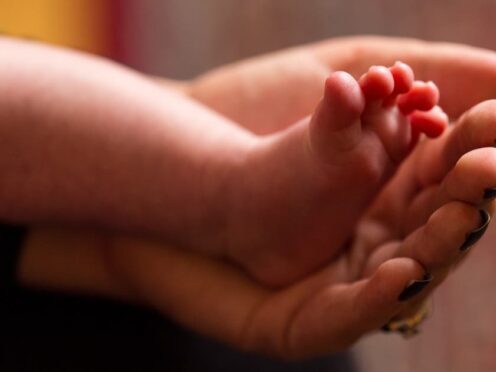
Five babies in England have died after being diagnosed with whooping cough, health officials have said amid a rapid rise in cases.
More than 2,700 whooping cough cases have been reported across England so far in 2024 – more than three times the number recorded in the whole of last year.
New UK Health Security Agency (UKHSA) figures show there were 2,793 cases reported to the end of March.
That compares to 858 cases for the whole of 2023.
The UKHSA said between January and the end of March, there have been five infant deaths.

UKHSA consultant epidemiologist Dr Gayatri Amirthalingam said: “Whooping cough can affect people of all ages, but for very young babies it can be extremely serious.
“Our thoughts and condolences are with those families who have so tragically lost their baby.”
In March alone, some 1,319 cases were reported, according to the provisional data.
The bacterial infection, also known as pertussis, affects the lungs and breathing tubes.
Whooping cough can be called the “100-day cough” because of how long it can take to recover from it, and it spreads very easily.
There were 556 cases recorded in January and 918 in February.
Pregnant women are being urged to take up the offer of the whooping cough vaccine so they can pass on protection to their babies, which should last until they are old enough to get vaccinated themselves.
Between January and the end of March, 108 babies under the age of three months were diagnosed with whooping cough. Some 51% of cases during this period were among those aged 15 and older.
Health officials describe whooping cough as a “cyclical disease”, which means it peaks every few years. With whooping cough this is every three to five years.
The last big increase was seen in 2016, but cases dipped to very low numbers during the coronavirus pandemic which means the current peak is “overdue”, the UKHSA said.
It added the impact of the pandemic means there is “reduced immunity in the population”.
UKHSA also said vaccine uptake has fallen in recent years – both the jabs for pregnant women and children.
Dr Amirthalingam added: “Vaccination remains the best defence against whooping cough and it is vital that pregnant women and young infants receive their vaccines at the right time.”
The NHS recommends all pregnant women are vaccinated against whooping cough between 16 and 32 weeks.
Immunity from the jab passes through the placenta to protect newborn babies in their first weeks of life.
When a baby is eight weeks old they are offered the six-in-one vaccine, which includes immunisation against whooping cough.
The second dose of the vaccine is offered at 12 weeks and the third is offered at 16 weeks.
When children are three years and four months they will be offered the four-in-one pre-school booster, which protects against pertussis.
Professor Sir Stephen Powis, national medical director for the NHS in England, said: “With cases of whooping cough continuing to rise sharply across the country, and today’s figures sadly showing five infant deaths, it is vital that families come forward to get the protection they need.
“If you are pregnant and have not been vaccinated yet, or your child is not up-to-date with whooping cough or other routine vaccinations, please contact your GP as soon as possible, and if you or your child show symptoms ask for an urgent GP appointment or get help from NHS 111.”
Whooping cough (pertussis) cases are currently very high, & the disease can be life-threatening for newborn babies.
If you're pregnant, it's important to take up the #Pertussis vaccine when offered. It helps protect your baby in their first weeks of life https://t.co/psHCZoBTLq pic.twitter.com/jYM60OKR2f
— UK Health Security Agency (@UKHSA) May 7, 2024
UKHSA said the first signs of whooping cough are similar to a cold, such as a runny nose and sore throat, but after about a week, the infection can develop into coughing bouts that last for a few minutes and are typically worse at night.
Young babies may also make a distinctive “whoop” or have difficulty breathing after a bout of coughing, though not all babies make this noise which means whooping cough can be hard to recognise.
Commenting on the figures, Dr Michael Head, senior research fellow in global health at the University of Southampton, said: “This new data alas illustrates just how serious whooping cough is – it can and does kill babies.
“Whooping cough can have a very long infectious period of around two to three weeks, i.e the period of time when an infected individual is able to transmit the bacteria onto others. Thus, there may be plenty of opportunities for people to mix, transmission to occur, and for there to be an infection of a vulnerable individual, such as a baby.
“A high coverage of vaccination is vital in reducing transmission within populations. Vaccine uptake in young children and for expectant mothers during pregnancy is so important. The vaccine is safe, and extremely effective.”
Professor Andrew Preston, from the Milner Centre for Evolution at the University of Bath, added: “It is extremely sad news to hear of the deaths of five babies, especially as whooping cough is a vaccine preventable disease.
“While no vaccine is perfect, pertussis vaccination of mums during pregnancy and of infants protect the babies and infants who are the most vulnerable to this serious, and sometimes fatal, disease.”

Enjoy the convenience of having The Sunday Post delivered as a digital ePaper straight to your smartphone, tablet or computer.
Subscribe for only £5.49 a month and enjoy all the benefits of the printed paper as a digital replica.
Subscribe